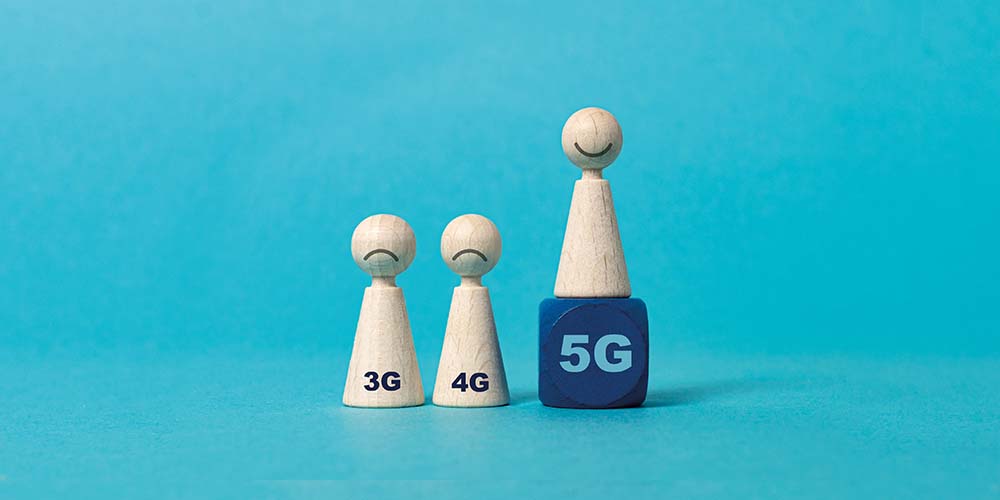5g Services in India Unlocking Job Growth Potential

India has over 65 million smartphone users, out of which 1.2 billion have mobile phone connections. This will increase quickly, reaching 80 cr in the following 1–1.5 years and roughly 100 Cr by 2026! The rollout of 5G services in India began in October 2022, and by the end of 2024, the majority of India will be covered by the technology since telecom providers are working around the clock to make the 5G network a success.
The maximum speed of 1G was 2.4 kbps.
2G cellular phones were used for data as well as voice, SMS, internal roaming , conference calls, call hold and billing based on services, e.g., charges for long distance calls and real time billing. The maximum speed of 2G was 50 kbps, or 1 Mbps with (EDGE).
3G set the standards for most of the wireless technology we have come to know and love. In the third generation, multimedia features like Web browsing, email, video downloading, picture sharing, and other smartphone features were added. Introduced commercially in 2001.
4G amended mobile web access, IP telephony , gaming services, high-definition mobile TV, video conferencing, 3D television, and cloud computing.
The fact that 5G has substantially quicker data transfer rates than 4G is its main advantage. Insanely high data transfer speeds of up to 20 GB/s are possible on 5G networks. For reference, 5G data transfer rates are 20 times quicker than those of 4G. The improved wireless technology also guarantees a latency of less than one millisecond. This means that AR, VR, and MR experiences can be more immersive, and IoT applications can be more reliable and run in real time. Additionally, it creates opportunities for autonomous vehicles and other similar use cases. Everyone, from gamers to governments, will gain from a new set of 5G use cases and applications that combine connectivity, intelligent edges, and Internet of Things (IoT) technology.
5G and IoT are a natural pairing that will impact nearly every industry and consumer by giving devices near real-time ability to sense and respond. Broadband-like mobile service: high-definition streaming video without dreaded buffering.
5G for consumers
Consumer expectations and demand for new services are rising as 5G networks go live. For service providers, 5G holds the promise of innovative client experiences that will spur revenue growth.
The majority of communication service providers’ revenues come from the consumer market. New opportunities are being created in a variety of consumer sectors, including:
- New user experience
- Mobile gaming
- Fixed wireless access
In addition to the direct income contributions from these new business sectors, service innovation will be essential to fostering expansion in the connection industry.
5G for business
When examining the benefits of 5G for business transformation, numerous significant common traits become apparent, such as:
-The ability to perform any process remotely, regardless of how vital it is for real-time control of any business operation, automating processes, utilizing compute resources when appropriate, and running edge apps when necessary to achieve higher security levels without compromising overall performance.
The Government of India has introduced the “Production Linked Incentive Scheme for Telecom and Networking Products” so as to attract large-scale investments in telecom equipment manufacturing and augment the domestic production capacity.
5G edge computing will enable businesses to maximize their data usage and act upon insights quickly. AI can process massive amounts of data quickly with fast connections. For instance, in a smart city, AI can automatically adjust traffic lights when a new apartment complex is built. AI-assisted security and machine vision can secure facilities by recognizing possible threats or unauthorized visitors.
Gaming will be more captivating with 5G. HD streaming will have faster speeds and less latency, so gaming won’t need devices with a lot of power. Businesses can leverage 5G to gain revenue, reduce operational costs, and enhance the customer experience.
Healthcare
Doctors and patients will be able to stay more connected than ever before thanks to 5G healthcare use cases. Wearable medical devices, such as an internal defibrillator, can alert a team of ER cardiologists in advance of a patient’s arrival. This data can be used to provide a full record of the patient.
Retail
The consumer experience will be crucial for 5G retail applications. The aisles of packed shelves from today’s stores might not exist in tomorrow’s stores.
Agriculture
The farms of the future will use more data and fewer chemicals.
Manufacturing
The confluence of 5G, AI, and IoT will completely transform factory floors. Aside from predictive maintenance, which helps control costs and minimize downtime, factories will use 5G to control and analyze industrial processes with unprecedented precision.
Logistics
With 5G services in India, fleet monitoring and navigation will become much easier at scale. An augmented reality system that identifies and flags potential hazards without diverting a driver’s attention away from the road could potentially power driver navigation.
Expected Job Growth :
-Installation and maintenance: 1L jobs
-Sales of handsets and broadband connections: 50000
-Technology jobs: 4mn to 6mn new jobs by 2026 in the areas of AI/ML/Engineers/IoT/ Private Networks/ MVNO/Apps/ Gaming Spectrum Management
In the next several years, businesses from a variety of industries, including automotive, manufacturing, healthcare, and education, are anticipated to adopt 5g Services in India in significant numbers. This indicates that there will be a need for staff that is knowledgeable about the new technology and how it operates, and as more and more industry sectors adopt 5G, the entire ecosystem is projected to change and India will be propelled toward a digital economy.
Latest Blogs
Financial Inclusion in India: Tech’s Impact on BFSI and Jobs
How Technological Advancements Aid Expansion and Impact Job Creation Earlier this year, the Finance Minister emphasized India's need for significantly larger banks, potentially three times...
Read MoreE-commerce in India: Distribution Channels and the Way Forward
Factors Affecting Channels of Distribution Consumer Preferences: Indian consumers are becoming more discerning and demanding, influencing distribution strategies. They seek convenience, quality, and a wide...
Read MoreThe Importance of Diversity and Inclusion: Beyond the C-Suite Directive
Closing inclusivity gap In an era marked by profound demographic shifts, technological advancements, and global interconnectedness, diversity and inclusion are more crucial than ever. A...
Read MoreThe Production Linked Incentive – Journey so Far
Slowing Investment in Key Sectors Under PLI Scheme in India Investment in key sectors identified to boost domestic manufacturing under the Centre's Production-Linked Incentive (PLI)...
Read MoreFormalisation of India’s Labour Market
Government Initiatives The government has launched several initiatives aimed at transitioning to a more formal labour market: Make in India: This initiative aims to make...
Read More





